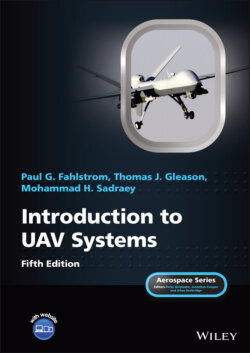Читать книгу Introduction to UAV Systems - Mohammad H. Sadraey - Страница 69
3.2 Aerodynamic Forces
ОглавлениеThe primary function of the UAV aerodynamic components (e.g., wing and tail) is to generate sufficient lift force or simply lift (L). However, they have two other aerodynamic products, namely drag force or drag (D) and nose‐down (Figure 3.2) pitching moment (M). While a UAV designer is looking to maximize the lift, the other two (drag and pitching moment) must be minimized. In this chapter, lift and drag are presented, while in Chapter 5, the pitching moment will be introduced.
Figure 3.1 Forces on an air vehicle during a level flight
Figure 3.2 Aerodynamic lift, drag, and pitching moment
The aerodynamic forces of lift and drag [8] are functions of the following factors: (1) aircraft configuration, aircraft/wing angle of attack (α), (3) aircraft geometry, (4) airspeed (V), (5) air density (ρ), (6) Reynolds number of the flow, and (7) air viscosity:
(3.1)
(3.2)
where ρ is air density, V is velocity, S is the wing planform area, and CL and CD are the lift and drag coefficients respectively. The calculations of lift and drag coefficients will be presented in the coming sections.
The lift force or simply lift is always defined as the component of the aerodynamic force perpendicular to the relative wind. The drag is always defined as the component of the aerodynamic force parallel to the relative wind (V∞). In other words, lift is always perpendicular and drag is always parallel to the relative wind. Figure 3.2 shows an airfoil section and the directions of lift and drag.
In reality, the aerodynamic force is located at the center of pressure (cp), which is moving with the variations of angle of attack (α). However, the aerodynamic center (ac) which is frequently selected to be the center of lift, is located nearly at the quarter chord (i.e., 1/4 of C). The pitching moment is the bi‐product of moving the location of aerodynamic force from cp to ac. The moment can be taken with respect to any point, but traditionally is taken about a point 25% rearward of the wing leading edge, known as the quarter chord. The aerodynamic center has a desired property – the variation of moment coefficient with respect to the angle of attack is zero (i.e., moment coefficient remains constant).
